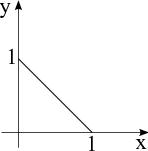m |
|||
| Line 1: | Line 1: | ||
| − | == Example | + | == Example. Two jointly distributed random variables == |
| − | Two joinly distributed random variables <math>\mathbf{X}</math> and <math>\mathbf{Y}</math> have joint pdf | + | |
| + | Two joinly distributed random variables <math>\mathbf{X}</math> and <math>\mathbf{Y}</math> have joint pdf | ||
<math> | <math> | ||
| Line 8: | Line 9: | ||
0 & ,\textrm{ elsewhere.} | 0 & ,\textrm{ elsewhere.} | ||
\end{array}\end{cases} | \end{array}\end{cases} | ||
| − | </math> | + | </math> |
| − | === (a) === | + | === (a) === |
| − | + | ||
| − | [[Image: | + | Find the constant <math>c</math> such that <math>f_{\mathbf{XY}}(x,y)</math> is a valid pdf. |
| + | |||
| + | [[Image:ECE600 Example Two jointly distributed random variables1.jpg]] | ||
<math>\iint_{\mathbf{R}^{2}}f_{\mathbf{XY}}\left(x,y\right)=c\cdot Area=1</math> where <math>Area=\frac{1}{2}</math>. | <math>\iint_{\mathbf{R}^{2}}f_{\mathbf{XY}}\left(x,y\right)=c\cdot Area=1</math> where <math>Area=\frac{1}{2}</math>. | ||
| Line 21: | Line 23: | ||
</math> | </math> | ||
| − | === (b) === | + | === (b) === |
| − | Find the conditional density of <math>\mathbf{Y}</math> conditioned on <math>\mathbf{X}=x</math>. | + | |
| + | Find the conditional density of <math>\mathbf{Y}</math> conditioned on <math>\mathbf{X}=x</math>. | ||
<math> | <math> | ||
f_{\mathbf{Y}}\left(y|\left\{ \mathbf{X}=x\right\} \right)=\frac{f_{\mathbf{XY}}\left(x,y\right)}{f_{\mathbf{X}}(x)}. | f_{\mathbf{Y}}\left(y|\left\{ \mathbf{X}=x\right\} \right)=\frac{f_{\mathbf{XY}}\left(x,y\right)}{f_{\mathbf{X}}(x)}. | ||
| − | </math> | + | </math> |
<math> | <math> | ||
f_{\mathbf{X}}(x)=\int_{-\infty}^{\infty}f_{\mathbf{XY}}\left(x,y\right)dy=\int_{0}^{1-x}2dy=2\left(1-x\right)\cdot\mathbf{1}_{\left[0,1\right]}(x). | f_{\mathbf{X}}(x)=\int_{-\infty}^{\infty}f_{\mathbf{XY}}\left(x,y\right)dy=\int_{0}^{1-x}2dy=2\left(1-x\right)\cdot\mathbf{1}_{\left[0,1\right]}(x). | ||
| − | </math> | + | </math> |
<math> | <math> | ||
f_{\mathbf{Y}}\left(y|\left\{ \mathbf{X}=x\right\} \right)=\frac{f_{\mathbf{XY}}\left(x,y\right)}{f_{\mathbf{X}}(x)}=\frac{2}{2\left(1-x\right)}=\frac{1}{1-x}\textrm{ where }0\leq y\leq1-x\Longrightarrow\frac{1}{1-x}\cdot\mathbf{1}_{\left[0,1-x\right]}\left(y\right). | f_{\mathbf{Y}}\left(y|\left\{ \mathbf{X}=x\right\} \right)=\frac{f_{\mathbf{XY}}\left(x,y\right)}{f_{\mathbf{X}}(x)}=\frac{2}{2\left(1-x\right)}=\frac{1}{1-x}\textrm{ where }0\leq y\leq1-x\Longrightarrow\frac{1}{1-x}\cdot\mathbf{1}_{\left[0,1-x\right]}\left(y\right). | ||
| − | </math> | + | </math> |
| − | === (c) === | + | === (c) === |
| − | Find the minimum mean-square error estimator <math>\hat{y}_{MMS}\left(x\right)</math> of <math>\mathbf{Y}</math> | + | |
| + | Find the minimum mean-square error estimator <math>\hat{y}_{MMS}\left(x\right)</math> of <math>\mathbf{Y}</math> given that <math>\mathbf{X}=x</math>. | ||
<math> | <math> | ||
\hat{y}_{MMS}\left(x\right)=E\left[\mathbf{Y}|\left\{ \mathbf{X}=x\right\} \right]=\int_{\mathbf{R}}yf_{\mathbf{Y}}\left(y|\left\{ \mathbf{X}=x\right\} \right)dy=\int_{0}^{1-x}\frac{y}{1-x}dy=\frac{y^{2}}{2\left(1-x\right)}\biggl|_{0}^{1-x}=\frac{1-x}{2}. | \hat{y}_{MMS}\left(x\right)=E\left[\mathbf{Y}|\left\{ \mathbf{X}=x\right\} \right]=\int_{\mathbf{R}}yf_{\mathbf{Y}}\left(y|\left\{ \mathbf{X}=x\right\} \right)dy=\int_{0}^{1-x}\frac{y}{1-x}dy=\frac{y^{2}}{2\left(1-x\right)}\biggl|_{0}^{1-x}=\frac{1-x}{2}. | ||
| − | </math> | + | </math> |
| + | |||
| + | === (d) === | ||
| − | |||
Find a maximum aposteriori probability estimator. | Find a maximum aposteriori probability estimator. | ||
<math> | <math> | ||
\hat{y}_{MAP}\left(x\right)=\arg\max_{y}\left\{ f_{Y}\left(y|\left\{ \mathbf{X}=x\right\} \right)\right\} | \hat{y}_{MAP}\left(x\right)=\arg\max_{y}\left\{ f_{Y}\left(y|\left\{ \mathbf{X}=x\right\} \right)\right\} | ||
| − | </math> | + | </math> |
but <math>f_{Y}\left(y|\left\{ \mathbf{X}=x\right\} \right)=\frac{1}{1-x}\cdot\mathbf{1}_{\left[0,1-x\right]}\left(y\right)</math>. Any <math>\hat{y}\in\left[0,1-x\right]</math> is a MAP estimator. The MAP estimator is '''NOT''' unique. | but <math>f_{Y}\left(y|\left\{ \mathbf{X}=x\right\} \right)=\frac{1}{1-x}\cdot\mathbf{1}_{\left[0,1-x\right]}\left(y\right)</math>. Any <math>\hat{y}\in\left[0,1-x\right]</math> is a MAP estimator. The MAP estimator is '''NOT''' unique. | ||
Revision as of 03:21, 15 November 2010
Example. Two jointly distributed random variables
Two joinly distributed random variables $ \mathbf{X} $ and $ \mathbf{Y} $ have joint pdf
$ f_{\mathbf{XY}}\left(x,y\right)=\begin{cases} \begin{array}{ll} c & ,\textrm{ for }x\geq0,y\geq0,\textrm{ and }x+y\leq1\\ 0 & ,\textrm{ elsewhere.} \end{array}\end{cases} $
(a)
Find the constant $ c $ such that $ f_{\mathbf{XY}}(x,y) $ is a valid pdf.
$ \iint_{\mathbf{R}^{2}}f_{\mathbf{XY}}\left(x,y\right)=c\cdot Area=1 $ where $ Area=\frac{1}{2} $.
$ \therefore c=2 $
(b)
Find the conditional density of $ \mathbf{Y} $ conditioned on $ \mathbf{X}=x $.
$ f_{\mathbf{Y}}\left(y|\left\{ \mathbf{X}=x\right\} \right)=\frac{f_{\mathbf{XY}}\left(x,y\right)}{f_{\mathbf{X}}(x)}. $
$ f_{\mathbf{X}}(x)=\int_{-\infty}^{\infty}f_{\mathbf{XY}}\left(x,y\right)dy=\int_{0}^{1-x}2dy=2\left(1-x\right)\cdot\mathbf{1}_{\left[0,1\right]}(x). $
$ f_{\mathbf{Y}}\left(y|\left\{ \mathbf{X}=x\right\} \right)=\frac{f_{\mathbf{XY}}\left(x,y\right)}{f_{\mathbf{X}}(x)}=\frac{2}{2\left(1-x\right)}=\frac{1}{1-x}\textrm{ where }0\leq y\leq1-x\Longrightarrow\frac{1}{1-x}\cdot\mathbf{1}_{\left[0,1-x\right]}\left(y\right). $
(c)
Find the minimum mean-square error estimator $ \hat{y}_{MMS}\left(x\right) $ of $ \mathbf{Y} $ given that $ \mathbf{X}=x $.
$ \hat{y}_{MMS}\left(x\right)=E\left[\mathbf{Y}|\left\{ \mathbf{X}=x\right\} \right]=\int_{\mathbf{R}}yf_{\mathbf{Y}}\left(y|\left\{ \mathbf{X}=x\right\} \right)dy=\int_{0}^{1-x}\frac{y}{1-x}dy=\frac{y^{2}}{2\left(1-x\right)}\biggl|_{0}^{1-x}=\frac{1-x}{2}. $
(d)
Find a maximum aposteriori probability estimator.
$ \hat{y}_{MAP}\left(x\right)=\arg\max_{y}\left\{ f_{Y}\left(y|\left\{ \mathbf{X}=x\right\} \right)\right\} $
but $ f_{Y}\left(y|\left\{ \mathbf{X}=x\right\} \right)=\frac{1}{1-x}\cdot\mathbf{1}_{\left[0,1-x\right]}\left(y\right) $. Any $ \hat{y}\in\left[0,1-x\right] $ is a MAP estimator. The MAP estimator is NOT unique.


